Update: My transfer is complete after 3 business days. $7,885 bonus posted. Robinhood offers an improved 3% match on IRA contributions if you subscribe to their Gold membership, which costs either $5 or $6.99 per month. Through 4/30/24, you can also get a 3% match on IRA transfers and 401k/403b/457/401a rollovers. Please start with my initial 3% IRA Match overview, the Robinhood FAQ, and Robinhood Terms & Conditions [pdf]. After doing hours of additional research, this is a follow-up post with a lot of details for other folks that also like to cover all the bases.
I’m have just completed my own transfer, and here’s the full walkthrough:
- Open a Robinhood brokerage account (done years ago) and put some money inside. If you haven’t opened one before, here is my referral link. It is overwhelmingly likely you’ll only get $5 of stock (as will I), but there is a very tiny chance you’ll get $200.
- Signed up for Robinhood Gold (first 30-days free, then $5 or $6.99/month). It is important you do this first, before the transfer.
- Opened a Roth IRA account on 4/10 (leave empty). I declined Securities Lending, as it removes SIPC protection.
- Requested a transfer from Vanguard Roth IRA on 4/11 (all Vanguard ETFs inside).
- Received email “Roth IRA account transfer request has been accepted’ on 4/15.
- Received email “Good news! Your Roth IRA account transfer was completed” very late 4/16 (technically 4/17). So it took 3-4 business days, faster than the estimated 5-7 business day.
- Robinhood credited the 3% immediately upfront (~$7,885). To keep it, I need to keep the transferred balance + bonus amount in the IRA for 5 years. I also need to keep paying for Robinhood Gold for a full year past the bonus paid date. I plan to turn on automatic dividend reinvestment and not touch it for 5 years.
- I don’t plan on making future IRA contributions into Robinhood, as I don’t want to keep my IRA there past 5 years. (Let’s say you put in $100,000 in Year 1 and then $7,000 in Year 2, Year 3, Year 4, Year 5. If you attempt to take out any amount at all in Year 6, how can you designate that money as part of the “old” $100,000 and not any of the more recent $7,000 contributions? It would just seem like you’re taking out part of the $7,000 contribution from Year 5 and thus lose that match, right?)
Here are some screenshots from the process:
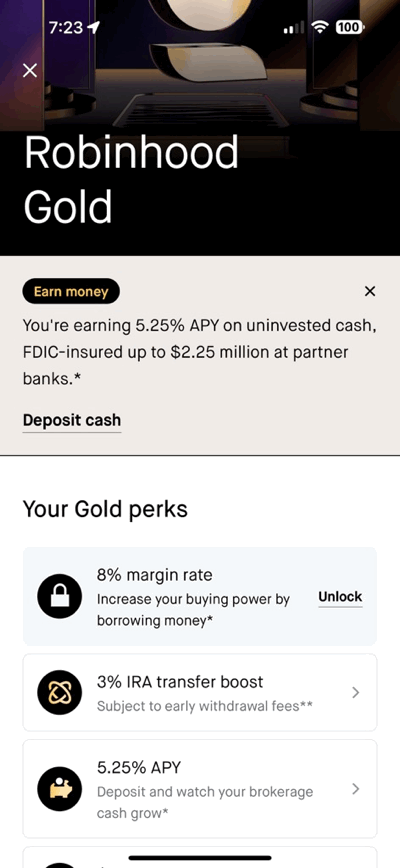
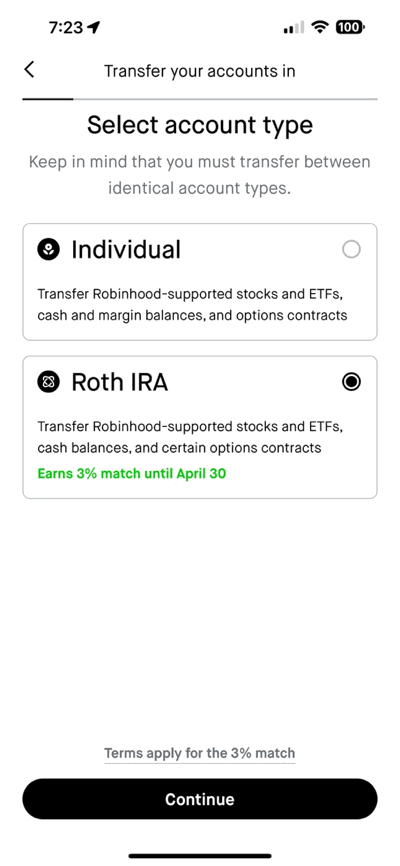
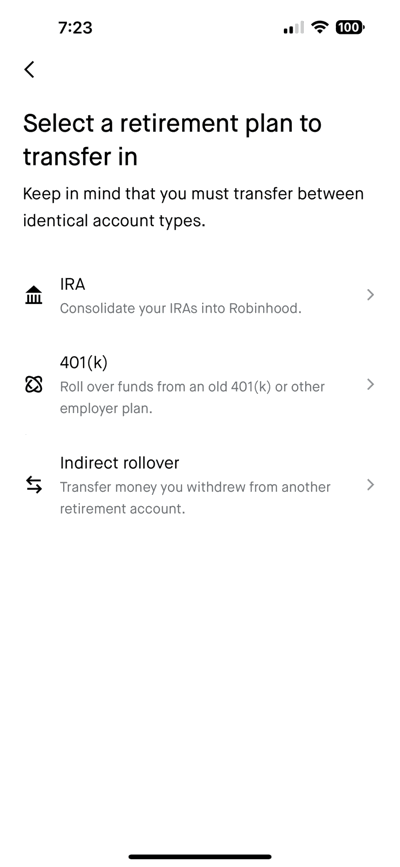
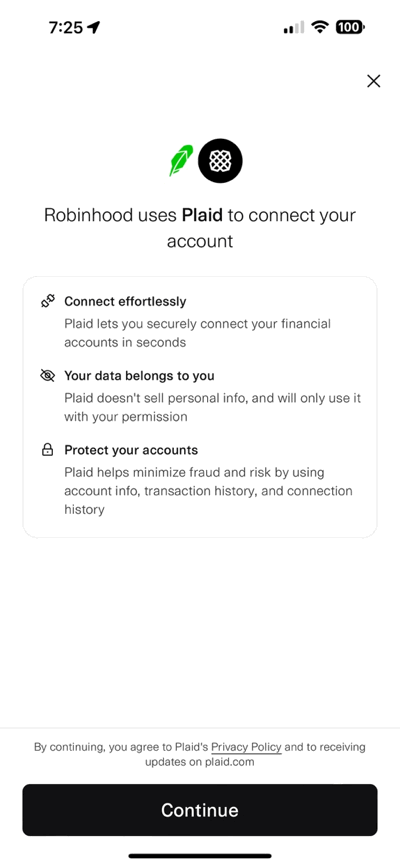
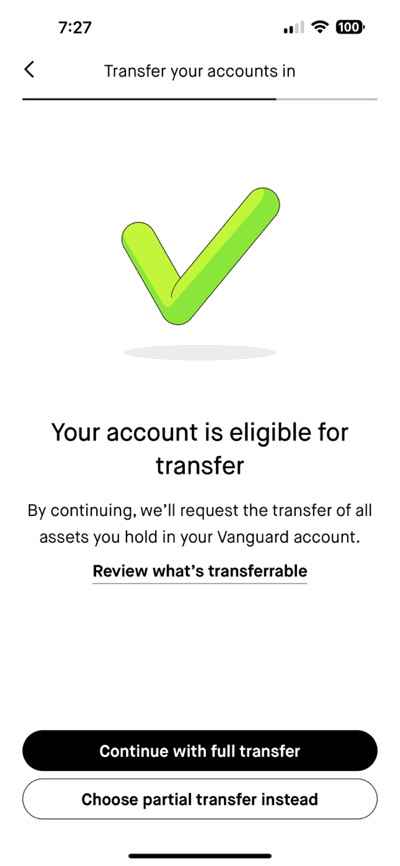
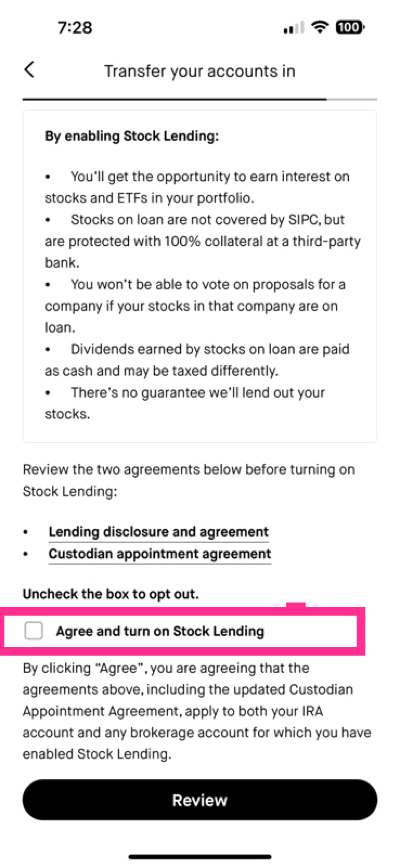
Robinhood doesn’t allow all asset types, so you can’t own mutual funds, individual bonds, and closed-end funds. Robinhood is not a full-featured brokerage firm. Here is the full list of what is and isn’t allowed. They support the following:
- U.S. exchange-listed stocks and ETFs
- Options contracts for U.S. Exchange-Listed Stocks and ETFs
- ADRs for over 650 globally-listed companies
This means that if you want to move your balance over to Robinhood, you will have to sell any mutual funds (or convert them to ETFs), individual bonds, brokered CDs, and so on. I converted my Vanguard mutual funds to ETFs, and it took 1-2 business days.
SIPC insurance limits and excess insurance. Robinhood is a member of the Securities Investor Protection Corporation (SIPC), which steps if a broker fails. Robinhood has also purchased additional excess SIPC insurance on the private market. From the Robinhood site:
Robinhood Financial LLC and Robinhood Securities, LLC are both members of SIPC, which protects securities for customers of its members up to $500,000 (including $250,000 for claims for cash). Explanatory brochure available upon request or at www.sipc.org.
We’ve purchased an additional insurance policy for Robinhood Markets, Inc., Robinhood Financial LLC, and Robinhood Securities, LLC to supplement SIPC protection. The additional insurance becomes available to customers in the event that SIPC limits are exhausted. This additional insurance policy provides protection for securities and cash up to an aggregate of $1 billion, and is limited to a combined return to any customer of $50 million in securities, including $1.9 million in cash. Similar to SIPC protection, this additional insurance doesn’t protect against a loss in the market value of securities.
From SIPC.org::
SIPC protects against the loss of cash and securities – such as stocks and bonds – held by a customer at a financially-troubled SIPC-member brokerage firm. The limit of SIPC protection is $500,000, which includes a $250,000 limit for cash.
Is SIPC a U.S. Government Agency?
No. SIPC is not an agency or establishment of the United States Government. SIPC is a non-profit membership corporation created under the Securities Investor Protection Act.
My brokerage firm has excess SIPC insurance. How does that work?
Excess SIPC insurance is insurance provided by a private insurer and not by SIPC. The insurance is intended to protect brokerage customers against the risk that customers will not recover all of their cash and securities in the proceeding under the Securities Investor Protection Act (SIPA). Under many of these policies, customer eligibility for recovery is not determined until after the SIPA liquidation of the customer’s brokerage firm has concluded and the amount of the customer’s recovery in that proceeding has been established.
Some people have concerns that Robinhood is a smaller company with a history of questionable judgment and violating securities regulations. Robinhood holds the current record for highest FINRA fine ever. As a result, you may choose to limit the amount transferred to Robinhood to under $500,000 in assets (and $250,000 cash) per eligible account type. Here are the different “capacities”. For example, you could have an individual taxable account, a traditional IRA, and a Roth IRA at Robinhood and each one would have $500,000 in coverage. I will be staying under these limits as well, but my IRA balance simply isn’t that big anyway.
Note that if you opt-in (or don’t opt-out) to Stock Lending during the account transfer or account opening process, any securities that are loaned out are no longer protected by the SIPC. This is usually offset by a promise of 100% collateral, but that assumes trust that Robinhood will post that collateral. See Gamestop short squeeze for a very recent example of Robinhood… not posting enough collateral. Therefore, I also don’t recommend Stock Lending with Robinhood.
Robinhood limitations on beneficiaries. Robinhood only allows a primary beneficiary who is an adult. That means no trusts, no minors, and no “per stirpes” instructions. See article.
Whom can I designate as my beneficiary?
To be eligible as a TOD or IRA beneficiary, the individual must be a person who is at least 18 years old, a US Citizen, or otherwise be legally permitted to open a Robinhood account.
The Robinhood Gold IRA Deposit Match counts as interest earned inside your IRA. From the official Terms and Conditions:
Robinhood processes and treats the Robinhood Gold IRA Deposit Match as interest earned by the IRA account for tax reporting purposes. The interest amount is based on a percentage of contributions made into the IRA Account. The interest earned by the IRA account will not be subject to, or impact, the maximum annual dollar contribution limit or the maximum annual deductible amount. Please note that the Robinhood Gold IRA Deposit Match may be taxable income for conversions of a non-deductible IRA contribution to a Roth IRA. Robinhood does not provide tax advice. You are encouraged to consult with your tax professional about appropriate tax reporting and treatment relating to this bonus award and the deposit of the bonus award in your account. Any taxes resulting from the bonus award are your responsibility.
From the FAQ:
Does the IRA match count toward my annual IRA contribution limit?
No. The IRA match counts as interest income in your IRA and doesn’t count toward your annual IRA contribution limit.How is the IRA match treated for tax reporting purposes?
The IRA match is treated as interest income in your IRA. We won’t deliver a 1099-INT due to the tax status of IRAs.
This important factor makes the effective value higher than the usual cash bonus that is taxable income. The amount gets to keep growing inside your Roth IRA, tax-free.
Robinhood will also reimburse your transfer fees up to $75 if you transfer at least $7,500 worth of assets. After the transfer is completed, you must contact then via the live chat function and they will reimburse you after you upload a screenshot of the fee charged.
When you transfer out eventually, Robinhood does charge a $100 Outgoing ACAT fee. Ideally, there will be another broker to reimburse that fee in the future, but who knows. Here is their full fee schedule [pdf].
Customer service tips. Robinhood does not have a traditional phone number to reach customer service. You have to go the help section, search for a topic, and then look for the “Contact Us” button at the bottom of the page (presumably after you have read the canned answer and still need help). Then you can either have a Live Chat or request a Callback where they will call you back on the phone at a later time.
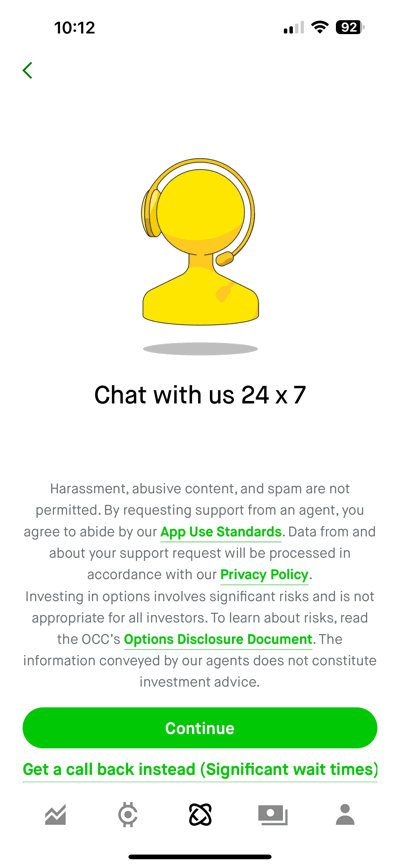
Security and Privacy tips. To access these settings on the iPhone app, click on the head/body icon on the bottom right, then the three lines icon on the top left, and then “Security and privacy”. On the plus side, Robinhood supports a variety of 2FA options: SMS, Device passkeys, and Authenticator apps. Scroll down further and you can also opt out of their data sharing.
The deadline is April 30th, and the terms state the transfer has to be “initiated and completed” by that date. As of right now, there’s still a decent buffer as it takes about a week for most IRA transfers. For those with large IRAs, this can be a very significant bonus. You may have reservations about moving your assets to Robinhood, which is certainly understandable. I hope this helps you make a more informed decision for your own situation.
Publisher: Source link
